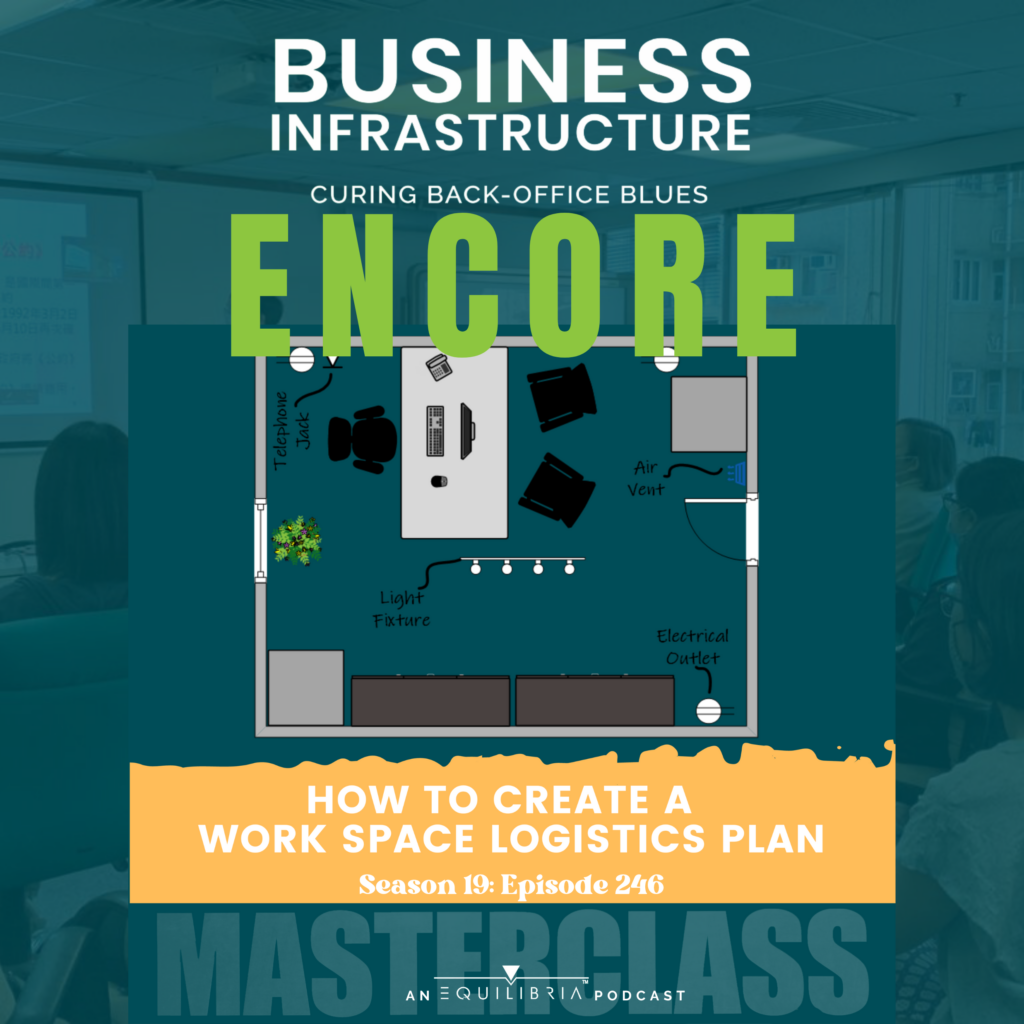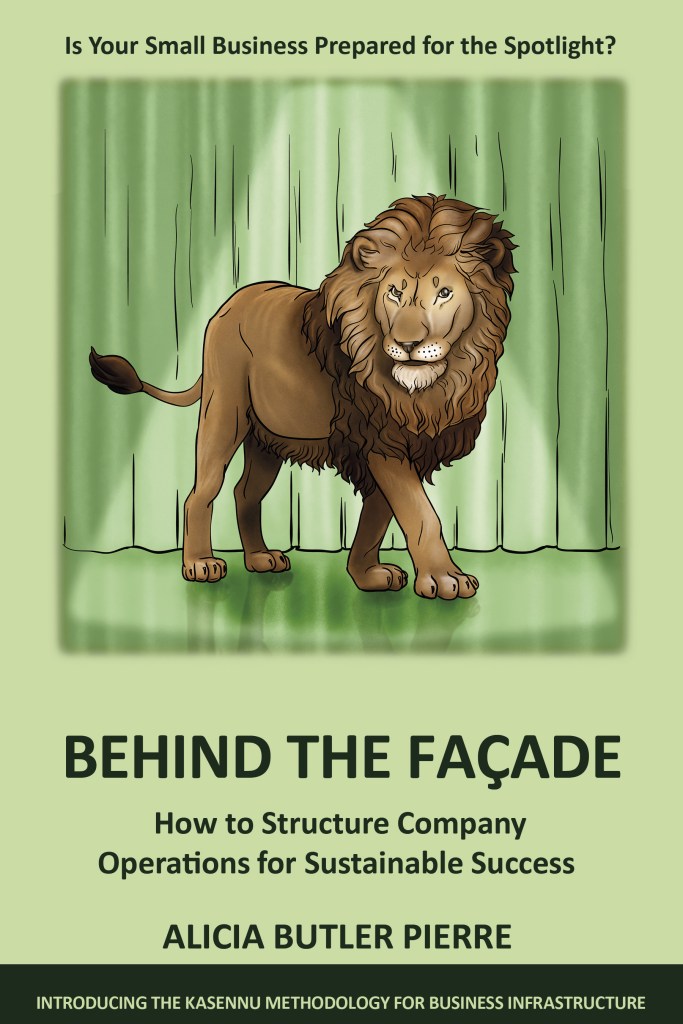Transcript
This episode originally aired on March 24th, 2022. In the last episode, you heard the story of ARD Smith, a fair but no-nonsense Navy veteran who has his eyes set on taking his fast-growing food distribution company. Public Preparing for an I P O will surely include audits among other due diligence activities. That’s why Dolores, the business infrastructure consultant, his company hires, helps them figure out a plan to get the administrative operations on the second-floor functioning just as seamlessly as the order processing operations. On the first floor, she creates a workspace logistics plan, a plan that optimizes the actual layout of all of their offices to maximize space, enhance communication, and improve productivity. This plan ends up addressing a large, underutilized room that could save them the cost of prematurely relocating. I’m Alicia Butler Pierre, and I’m about to teach you how to create a workspace logistics plan for your business, even if you work in a cubicle or from home. If you follow along by the end of this episode, you’ll also have a workspace that will supercharge your efficiency and capacity. Class is back in session. This is episode 2 46, how to Create a Workspace Logistics Plan. Let’s start the show.
Welcome to Business Infrastructure, the podcast about curing the back-office blues of fast-growing businesses. If you’re a business owner or operator looking for practical tips and solutions to scaling your business in a sustainable manner, you are in the right place. Now, here’s your hostess, Alicia Butler Pierre.
If a picture is worth a thousand words, then your workspace is layout, aesthetics, and functionality, worth a thousand pictures. What’s a workspace It’s the place where you perform most of your work. That could be on a production floor, at a home office, or maybe even at a desk tucked in the corner of a room. Speaking of home offices, there’s a sizable percentage of the working population that now works from home. This definitely became a trend during the pandemic and with so many of those people spending more time working than on personal matters, having this lesson about creating a workspace logistics plan is more important than ever. In the story of Claar Smith, his company has a combination of a production floor that’s organized into lines or work cells as well as administrative offices. Dolores Trend, the consultant that creates a workspace logistics plan for the clan’s company, creates a plan that takes into account their service delivery blueprint.
This helps her understand how each office should be laid out, as well as which offices should be in close proximity to enhance workflow. What’s a workspace logistics plan Let’s first consider the definition of the word logistics. According to Oxford’s Dictionary, logistics refers to quote the detailed coordination of a complex operation involving many people, facilities, or supplies. As mentioned, your workspace refers to the physical place where you primarily perform work. So combined, a workspace logistics plan is a plan for segmenting and organizing your space. According to your organization, departments consider the proper placement of all staff furniture and equipment to ensure a seamless workflow. It also consolidates or creates work zones based on how you, your team, and your customers interact with each other for more effective information exchange. In fact, it represents the sixth element of the CASA framework for business infrastructure. As a reminder, business infrastructure is a system for linking the people, processes, tools, and technologies that your company needs to operate and function on a day-to-day basis into a cohesive framework, allowing you to scale sustainably and profitably. There’re eight main steps I’ll describe for creating a workspace logistics plan. Admittedly, this is one of the more challenging exercises to describe orally, but as always, I’ll do my best to describe how to perform these steps. To simplify, I’ll share the steps for optimizing a single workspace that the best way to get all the details is by reading my book behind the facade, and how to structure company operations for sustainable Success. In particular, take a look at chapter seven.
Okay. Before we get started, I want to state a few disclaimers so we can kind of set the level of expectation for what you’re about to hear throughout the rest of this episode. Number one, I am not an architect or interior designer. I will repeat, I am not an architect or an interior designer, so the steps that you’re going to hear me describe in creating this workspace logistics plan, keep in mind it really, it’s all about the movement of physical objects as well as people. So, we won’t be talking about building new walls or tearing walls down, or constructing of anything new. Rather, it’s going to be about the movement of things, physical objects, and again, people that are already in place or already in existence, and it could potentially mean ordering additional, physical objects, if you will, to kind of spruce up your office or enhance productivity, whatever the purpose of that new object is.
What I’m about to describe to you also will not cover the effects of things like lighting, noise, and ergonomics and their effects on productivity. However, if you do want more information about ergonomics and how to set up your workspace, I strongly suggest checking out my video interview with Art OG Neve. And at the time of this recording, art is still a VP over at Logitech. He’s based in Switzerland, so you can find that episode by clicking on the resources link wherever you’re listening to this podcast in this episode’s description. The last thing I want to mention as a quick disclaimer, for those of you out there who are Lean Six Sigma consultants, practitioners, advisors, or some of this, you might listen to it and start thinking to yourself, this sounds a lot like creating what we call a balanced work cell or the five s framework.
Again, these are lean six Sigma terms and, and frameworks that we use in that space. But keep in mind, I’m going to describe steps for focusing on a single administrative type of workspace and not workspaces where actual production or retail activity may be taking place. So now that we have those disclaimers out of the way, let’s move on to step number one. And that is, as with all of your other lessons in this audio masterclass, prepare. So, here are some of the things that you’ll need in preparation for your workspace logistics plan. You’ll need a computer laptop or a tablet. You’ll need graphing paper and a pencil. Now, that is optional, but I do highly recommend getting some graphing paper and definitely a pencil so that you will have the ability to erase and draw over things as needed. The next thing you’ll need is a tape measure.
You’ll also need a copy of your business parts analysis or your business design blueprint, and here’s the reason why you want to be able to reference those documents so that you can kind of jog your memory as to, you should be able to, to know this off the top of your head at this point in the masterclass, but just in case you, you need a little memory jogging, you can easily reference all of the departments as well as the associated people or roles within those departments. Next, you’ll need a copy of your service delivery blueprint. If you haven’t done that, I highly encourage you to go through that exercise and create one for your organization. The reason that’s going to be so helpful for you with this Workspace Logistics plan is that it’s going to help you understand the optimal setup of your physical workspace that is in alignment with the optimal flow of information that’s identified in your service delivery blueprint.
Next, you’ll need maybe a word processing program like Microsoft Word or even a Google Doc, as well as a spreadsheet tool like Google Sheets or even Microsoft Excel. And the reason for that is to be able to capture a table of information that I will describe in just a few more minutes. And then lastly, I recommend using some type of drawing tool, a professional drawing tool like Microsoft Physio. You can also use PowerPoint, you can even use Google Slides, or Google has another really cool free app called Google SketchUp. So those are the things you need in preparation for your workspace Logistics plan. Step number two, tidy up. It’s so important to do this first, and what do I mean by tidying up Well, in short, decluttering, getting rid of all of that unnecessary paper, and other objects that might be taking up physical space wherever you predominantly work.
And as you start to go through that decluttering exercise, very similar to what we discussed in that paper records management tutorial, ask yourself, first of all, do you even need it Secondly, if it is needed, can it go into another space Can it be used by a someone else in another office or another workspace Once you’ve decluttered your space, now you have a clear view of what’s left over. The reason it’s so important, again, to tidy up is that you don’t want to go through the trouble of accounting for things that you ultimately won’t even keep around in your workspace. So go ahead, get rid of all of that stuff that isn’t needed. That way you’re left with everything that you truly do need to function in your day-to-day activities within your organization. And this is actually what Dolores if you remember in Lenard’s story, this is actually what she suggested that he and his team do.
First, if you’ll recall, they actually cleaned out this really large room that was just underutilized and really unused altogether. Well, it was used as storage space, but for the most part, it was valuable space that could be used for actual work activities and not just storage space. Now, in case your kind of wondering how to go through that decluttering activity, go back and reference both the paper records management and the electronic records management episodes in this audio masterclass, and that way you’ll get all of those step-by-step details on how to properly declutter and organize so that again, you can complete this first tidy up a step. So, step number three, take an inventory of all of your FFE. Now, FFE stands for furniture fixtures and equipment, and it’s an accounting term for a common expense line item that’s found usually on your profit and loss statement.
But here’s the gist of what I’m suggesting you do take an inventory of all of the equipment, furniture, and fixtures that require or are expected to consume physical space in your workspace. So, these are things like your desk, chair, table, printer, bookcase, file cabinet, and computer. You get the point. It’s also handy to have an inventory like this for business insurance purposes. Hopefully, you have business insurance, but if not, I definitely recommend as soon as you finish listening to this episode that you find yourself an insurance agent and secure some business insurance for yourself. This is one of the things that the insurance agent is going to ask you for. They will, and if not in inventory, they’ll definitely ask you for the total value of the things that are in your workspace. Now, at this point, go ahead and pull out that graphing paper or you can open up Microsoft Word or Excel directly at this point and draw a table that has three columns in that very first column.
Name that column, workspace inventory, or you could just type or write inventory and list everything that’s left over. Again, that takes up physical space that you would need to account for in your office or at your workspace. Go ahead and list all of that in that first column. Step number four, measure your space. Here’s where you’re going to take a tape measure to measure the length with impossible height. You might not need the height unless you are, you just have this, maybe a cubicle space. That might be a really great example when you would also want to measure the height of your physical workspace as well. But make sure you use that tape measure to go ahead and record those dimensions. Write it down on a sheet of paper, and if you’re in a commercial space, you probably already have access to the dimensions of your office, and if not, you might be able to ask someone, or probably more than likely, it’s just going to be easier for you to just quickly take the measurement yourself.
So now at this point, you’ve taken an inventory of all of your furniture fixtures and equipment. You’ve measured your physical workspace, including the length, width, and possibly even the height of your space. Now it’s time for step number five to measure all of your furniture fixtures and equipment. And you’re going to look at everything that you’ve listed on your table so far in the inventory and literally measure or capture those dimensions. So again, the length, the width, possibly even the height, and go ahead and record the measurements of everything that you have in your inventory directly onto that graphing paper where you may have your table, or if you have it in a word processing program or a spreadsheet program, go ahead and put that information in there. Again, when we talk about furniture, fixtures, and equipment, that can include things like bookcase desks, computers, printer chairs, file cabinets, et cetera.
The third column in your table is where you actually want to put the financial value of every single item in your inventory. This is especially helpful when you’re working with your business insurance company. They will ask for this information, so it’s helpful if you already have that put together. And then even if you don’t submit it to your business insurance company, it’s just always nice to have because you never know when something may happen. You have to replace an item for whatever reason if it’s stolen especially, and then, you might have to report it to your insurance company. You would at least know what the replacement value of that item is. Step number six is drawn on paper. Now, you may be thinking, I’m not an architect. I can’t do this. Oh, my goodness, you’re, you’re going to start talking to me about drawing things to scale.
What does that even mean Rest assured, I promise you can do this. Now, you don’t have to use graphing paper in your pencil. Personally, I find it really helpful to do this first, to always sketch things out on paper before I get into the software and start moving things around. Just because of the software, it usually takes a little bit longer because you’re being very specific about all of your dimensions. But when it comes to your graphing paper and using that pencil, the benefit of a pencil is that it has an eraser and you can easily just erase things. So, I recommend drawing it onto graphing paper first, and if you also decide to do it that way, here’s what I recommend. Draw the dimensions of your workspace first. So usually, you’re going to end up with maybe a square or even a rectangular shape on your graphing paper.
Now, it is important to draw, and scale, to make sure that your layout plan is realistic. And here’s what I mean. When you draw to scale, obviously, if you have a space that is several feet or several meters wide, you can’t draw that as is onto a sheet of paper, right So drawing to scale means that you usually assign, let’s say in the instance of graphing paper, you might have one square on that graphing paper, and you may say, every square on this graphing paper represents one foot or one centimeter. Whatever you decide to use as your scale, just make sure you write that somewhere at the very bottom of your graphing paper. That way, if you share this with anyone else, they’ll at least be able to understand and interpret it, and, it also helps you to able to recall your logic in drafting your workspace plan.
Now, depending on the complexity of your workspace and your company’s need for professional drawings or blueprints, you might want to enlist the services of an architect. But if you’re just trying to keep, keep it really simple, you don’t need anything fancy or complicated, go ahead and sketch it out on that graphing paper first. Again, if you decide to skip ahead and go to a drawing tool, now is the time to start doing that. So, if you have a hand sketch already that you can start working with, or if you want to go directly into a drawing tool, now is the time to start opening up a tool like Microsoft Vizio, or even Google SketchUp. As I mentioned earlier, you can even use PowerPoint or Google Slides. When you use PowerPoint or Google Slides. Just make sure that you use very basic shapes like squares, rectangles, and circles to represent all of the furniture fixtures and equipment, and be careful to draw them to scale.
So even though you may draw a small square that represents a chair, for example, if you’re using PowerPoint, I’m going to use PowerPoint as an example. If you have drawn out the dimensions of your overall workspace onto a PowerPoint slide, you may then draw a chair, for example, and you may have to think to yourself, how am I going to properly capture the correct dimensions of this chair, lengthwise, widthwise, and, and possibly even height Then there are ways that you can adjust the dimensions of all of those objects and get very specific. We don’t have time to get into those nitty gritty details here, but just know that you can definitely state the exact size that you want each object to be on your workspace plan when you’re using something that isn’t traditionally used as a drawing tool like Microsoft PowerPoint. So, once you have that sketched on paper, you’ve transferred it over to a drawing tool is something now that can be saved digitally and possibly shared with other people.
Now we can move on to step number seven, arrange or rearrange your workspace according to your service delivery blueprint. Now, here’s the time that you want to start moving things around on paper, or if you’re working directly on your digital drawing, you want to start moving things around first, before you physically start moving them around. Move it around on that paper or move it around on that digital copy of your drawing first. Now, if you only have one workspace that you’re working with, divide your workspace into what I call work zones, and that’s based on your department. So, for example, if you have an HR department, an IT department, and operations and accounting that’s for the department that I just named you might very well assign every corner of your room to one of those work zones. You might say the corner, the left, far left corner is where you’re going to keep everything that’s HR related.
The far-right corner is where everything that is accounting-related will be stored, and so forth, and so on. If your office is not the only workspace for your organization, this is when it’s going to be particularly helpful to use your service delivery blueprint to determine the primary purpose of your office as it relates to the overall delivery of goods and services to your customers. For example, if you work in the accounting department, the work that you perform may not come until the tail end of that overall process, which is collecting money usually. So just make sure that your workspace is set up in terms of proximity and the things that you have going on within your workspace to make sure that once that workflow gets to your particular office, things are moving as seamlessly as possible and the process itself can eventually just close out.
As I just mentioned, your service delivery blueprint also determines which offices or workstations should be situated in close proximity to maximize information flow. This very well may require relocating or swapping offices. That’s actually what happened in the case of our entrepreneur, Lenard, who we heard about in the last episode. Now, once you are in your workspace, again, I want to encourage you to organize your space into a U-shape, so all of the furniture fixtures and major pieces of equipment, organize that into a U-shape such that the center of your workspace remains clear so that you can move about uninhibited and possibly even in an assembly line type fashion. And what I mean by that is think about your own workflow, your own individual workflow in the midst of everything else that’s going on in your company, and set things next to each other such that if you were to start in a one-point in your office, you can move about either in a clockwise or counterclockwise direction.
But the point is you shouldn’t have to start at one point in your office and walk all the way across to the other side of your office in order to perform the next task within your overall workflow. Instead, you should be able to just move on to the next point, which might be either to your immediate left or your immediate right, and I hope that’s making sense to you. For example, if you are a one-person operation or if you have just one workspace that’s associated with your company, one of your departments might be sales and marketing, another department might be operations, and a third might be accounting. So, it would make sense to put your sales and marketing-related activities at one point in your office, the operational-related activities or furniture fixtures and equipment associated with operations directly next to your sales and marketing-related things.
And then after operations is when you would have anything that’s related to accounting. So that workflow there is if you start at the point of sales and marketing, that’s where you’re doing everything to attract and close the deal. Then you move on to operations, which involves the actual delivery of the goods and services. And then finally onto accounting, which is where you actually collect payment. Now, once you have, you’ve moved things around on paper and again, eventually into the drawing tool that you’re using, go ahead and print a copy or save a digital copy and email that, and share it with other people on your team if you have a team. If you do have a team, make sure you solicit their feedback because they may think of things that could affect the overall plans, and logistics that you may not have considered and make any necessary adjustments based on that feedback.
And once you’re satisfied with whatever it is that you have on paper or what you have drawn in your drawing tool, then you can start to physically rearrange, arrange, or possibly even relocate your office or your workspace altogether. Now, I highly recommend as Kard and his team did doing this kind of work on a day off or during the time, that’s outside of your primary work shift, and the reason is to obviously minimize disruption to your actual work schedule. And finally, we have step number eight spruce up. Now, you can start to do other things to really make your workspace come to life. You can do things like paint the walls. Now, I do recommend that before you start arranging, rearranging, and possibly even relocating your workspace if you can take everything out of there first and paint the walls, that’s always the best-case scenario, but if you can’t, that’s perfectly fine also. But you can also add additional personal touches like plants, rugs, and even artwork, and then communicate your office setup policies such as clutter reduction, cleanliness, and keeping with a certain color scheme that matches your company’s logo and culture. And there we have it. It’s not stepping A to Z, but from tidying up to sprucing up. Now you have your workspace logistics plan.
From tidying up to sprucing up. Having the right setup that stimulates a positive, efficient, and productive work environment is vital to communicating competency. This ensures that you attract the right customers, staff, potential partners, and in the clan’s case investors, you can replicate the eight steps I just described across every officer cubicle. If you’re in a suite or across multiple offices on multiple floors in multiple buildings, the point is a workspace logistics plan can scale up. It’s also worth mentioning that it’s possible to create a workspace logistics plan for a digital workspace. Tools like Microsoft SharePoint click-up and Notion work, especially well for fully remote or hybrid teams. The amount of time spent in implementing your workspace logistics plan can vary depending on several factors like the size of space, the amount of clutter ordering furniture and equipment, and whether relocation is involved, so expect anywhere from a couple of days to a month or longer.
There’re so many benefits to designing and implementing a workspace logistics plan. Some of those benefits include creating clutter-free and open workspaces that maximize floorspace stimulating communication among your team and using intelligent workspace design to improve perceptions of your company’s image to your clients as well as to your team. Saving money on office rental fees through the optimal use of digital, remote, and physical workspaces. Identifying or setting aside work areas to accommodate future staff members or team members, passing legally required office and retail space requirements, things like OSHA and a D relocating into a new office or retail space with minimal downtime. And finally, create a comfortable environment that matches your work style and company culture. This completes your sixth lesson in creating business infrastructure. At this point, you’ve identified the work to perform and who will perform it. Two, you’ve categorized that work into departments. Three, you’ve established a reporting structure based on those departments and roles. Four, you’ve organized your digital and physical assets as well as your physical workspace so that the information required to perform the work is protected and easy to access. And five, you’ve summarized how the people, processes, and tools come together to perform the work needed to provide goods and services.
Did you find this lesson helpful If so, please subscribe and leave a five-star rating and a review. If you want more details about how to create a Workspace logistics plan, then click the resources link. This episode’s description, it’ll lead you to our website business infrastructure. tv. That’s where you can learn more about my book that this masterclass is based on. It’s called Behind the Facade, how to Structure Company Operations for Sustainable Success, and I wrote it specifically for you, the owner, operator, manager, or consultant of a fast-growing small business. But that’s not all. When you click the resources link. In this episode’s description, you’ll also discover more about our services and how to join our mailing list for tips and special offers. There are also articles and a case study that you may find helpful in creating your Workspace logistics plan. Coming up in the next episode is the grand finale. All the entrepreneurs whose stories you’ve heard in this masterclass convene in Atlanta, Georgia for the highly anticipated Business Process workshop. This is where you’ll learn how to identify and document your organization’s key processes. This is by far our most requested business infrastructure service here at Equilibrium. So, you don’t want to miss this episode. Subscribe and stay tuned to get all the details. Until then, keep operating smoothly.
Thank you for listening to Business Infrastructure, the podcast about curing back-office blues with Alicia Butler. Pierre, if you like what you’ve heard, do us a favor and subscribe. Leave a rating and review, and more importantly, share with your colleagues and team members who could benefit from the information. Join us next week for another episode of Business Infrastructure with Alicia Butler. Pierre.









